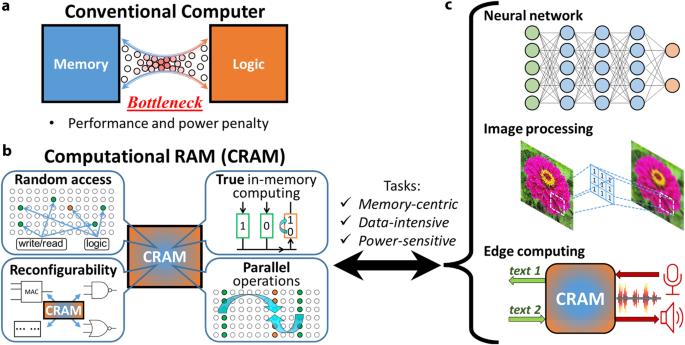Experimental demonstration of magnetic tunnel junction-based computational random-access memory
引用次数: 0
Abstract
The conventional computing paradigm struggles to fulfill the rapidly growing demands from emerging applications, especially those for machine intelligence because much of the power and energy is consumed by constant data transfers between logic and memory modules. A new paradigm, called “computational random-access memory (CRAM),” has emerged to address this fundamental limitation. CRAM performs logic operations directly using the memory cells themselves, without having the data ever leave the memory. The energy and performance benefits of CRAM for both conventional and emerging applications have been well established by prior numerical studies. However, there is a lack of experimental demonstration and study of CRAM to evaluate its computational accuracy, which is a realistic and application-critical metric for its technological feasibility and competitiveness. In this work, a CRAM array based on magnetic tunnel junctions (MTJs) is experimentally demonstrated. First, basic memory operations, as well as 2-, 3-, and 5-input logic operations, are studied. Then, a 1-bit full adder with two different designs is demonstrated. Based on the experimental results, a suite of models has been developed to characterize the accuracy of CRAM computation. Scalar addition, multiplication, and matrix multiplication, which are essential building blocks for many conventional and machine intelligence applications, are evaluated and show promising accuracy performance. With the confirmation of MTJ-based CRAM’s accuracy, there is a strong case that this technology will have a significant impact on power- and energy-demanding applications of machine intelligence.

基于磁隧道结的计算随机存取存储器的实验演示。
传统计算模式难以满足新兴应用(尤其是机器智能应用)快速增长的需求,因为大部分电力和能源都消耗在逻辑模块和内存模块之间的持续数据传输上。一种名为 "计算随机存取存储器(CRAM)"的新模式应运而生,以解决这一根本性限制。CRAM 直接使用内存单元本身执行逻辑运算,数据无需离开内存。先前的数值研究已经充分证明,CRAM 在传统应用和新兴应用中都具有能耗和性能优势。然而,目前还缺乏对 CRAM 的实验演示和研究,以评估其计算精度,而计算精度是衡量其技术可行性和竞争力的现实和应用关键指标。在这项工作中,对基于磁隧道结 (MTJ) 的 CRAM 阵列进行了实验演示。首先,研究了基本内存操作以及 2、3 和 5 输入逻辑运算。然后,演示了采用两种不同设计的 1 位全加法器。在实验结果的基础上,开发了一套模型来描述 CRAM 计算的准确性。标量加法、乘法和矩阵乘法是许多传统应用和机器智能应用的基本构件,对它们进行了评估,并显示出良好的精度性能。随着基于 MTJ 的 CRAM 的准确性得到确认,这项技术将对机器智能的高能耗应用产生重大影响。
本文章由计算机程序翻译,如有差异,请以英文原文为准。
求助全文
约1分钟内获得全文
求助全文

 求助内容:
求助内容: 应助结果提醒方式:
应助结果提醒方式:


